Giant's Causeway, Portrush and Bush Valley Tramway
History
Following a number of speculative and ultimately abortive schemes to build a railway or a tramway between Portrush and Giant's Causeway, powers were finally obtained — on the 26th August 1880 — under the Giant's Causeway, Portrush, and Bush Valley Railway and Tramways Act, 1880. The act authorised the construction of a 3ft 0ins-gauge railway between Dervock (where it would meet the tracks of the Ballycastle Railway), Bushmills and Giant's Causeway, and a 3ft 0ins-gauge tramway between Bushmills and Portrush; crucially for what was to come, the traction used could either be animal, mechanical or electrical. The act also incorporated a company — the Giant's Causeway, Portrush, and Bush Valley Railway and Tramways Company — to raise the necessary capital, and to construct and operate the railway/tramway.
The thinking behind the railway was that it would carry significant quantities of mineral traffic, particularly limestone and iron ore; however, this ran into serious opposition, not to mention difficulties raising the capital needed, so other than a short piece of track at Dervock, it was never built.
The leading lights behind the scheme were two forward-thinking brothers, William Atcheson Traill and Dr Anthony Traill, who not only made the scheme a reality, but also persuaded the British-German electrical engineer — Sir William Siemens — to take up £3,500 worth of shares, and for the UK arm of the company (Siemens Brothers) to be appointed as the electrical engineering contractors. The intention was not only to use electricity to power the tramway, but to generate the electricity by means of a hydroelectric plant.
This was, however, very early days for electric traction, and all attempts to use the tracks to bring and return the current to the cars proved fruitless due to electrical leakage. This was eventually solved by the use of a side-contact conductor rail, situated to one side of the tracks (the side away from the road) and at a height of 17ins (from the track level), though this form of current collection could of course not be used within the streets of Portrush and Bushmills. Whilst battery power was initially envisaged for operation within the latter, the batteries proved to be too heavy for the tramcars, so the company ended up ordering two Wilkinson steam trams.
Due to issues with water rights, the first services between Portrush and Bushmills, which commenced on the 29th January 1883, were steam operated. Although some services with electric traction are reported to have started on the 16th April 1883, the ceremonial opening did not take place until the 28th September 1883, making it the first hydro-electric powered tramway/railway in the world. The hydro-electric plant had by this time been supplemented by a steam engine and dynamo at Portrush depot, though the electric cars could of course not enter Portrush itself, nor use the branch into Bushmills Market Place.
New powers were obtained on the 6th August 1885 — under the Giant's Causeway, Portrush, and Bush Valley Railway and Tramways Act, 1885 —to abandon portions of the authorised railway, to raise more capital, and to extend the tramway from Bushmills to Giant's Causeway. The new extension was opened on the 1st July 1887, and took the tramway to its final size of 9.25 miles. From Eglinton Street outside Portrush Railway Station, the line ran southeastwards inland along Causeway Street, Bushmills Road and Dunluce Road, before gaining the coast in the neighbourhood of White Rocks. The first 0.75 miles of the line were street running, thereafter to north side of the road, which had to be specially widened to accommodate the tramway. From White Rocks, the line continued eastwards via Clooney Hill and Dunluce Castle, before heading southeastwards inland to Bushmills, where there was a short branch into the Market Place. The main line now headed northwards over the road to Port Ballintree then northeastwards over the River Bush to the terminus just below the Causeway Hotel.
in 1884, the tramway had two steam engines, four electric tramcars, six trailers and fourteen wagons. A third Wilkinson steam engine arrived in 1886 and the last in 1896, the latter to replace one of the two earliest machines. Additional electric tramcars and trailers were ordered in 1888, presumably to meet the demand.
Following the death of a cyclist in in 1895, whose head struck the side-conductor, the Board of Trade seems to have put its foot down with regard to this form of current collection, instructing the company to either raise the conductor to a height of 8ft, or find an alternative mode of traction; meanwhile the current was limited to 250 volts, only sufficient to power a single tramcar. This led the company to greatly increase the use of steam traction, and was probably the main reason for ordering the fourth and last steam engine. The company seems to have been more than happy to use steam traction, as the engines were significantly more powerful than the electric tramcars, so could haul many more passengers per journey, and they would of course be able to traverse the entire route. The company's somewhat relaxed attitude to the number of trailers hauled by a steam tram led to difficulties with the board of trade, which only ever authorised the use of two (across the UK), whereas the GCP&BVR&TCo frequently ran four per engine, and allegedly up to six.
The Grand Jury provisionally authorised conversion of the line to overhead current collection in 1896, but the company had trouble raising the necessary capital to carry out the conversion. The money was, however, eventually found, the line switching to overhead current collection on the 26th July 1899. The company also invested in rebuilding two of the existing tramcars with more powerful motors, new generating plant, and a completely new tramcar in 1902. With new, more powerful electric trams, the percentage of mileage hauled by steam traction was reduced from 80% in 1897 to 23% in 1901.
By 1909, the company was operating four electric tramcars and two steam engines, the latter contributing a mere 8% of the mileage run. The oldest steam engine (No 1) was scrapped in 1910, its sister (No2) having been scrapped in 1899. The remaining engines (Nos 3 and 4) hardly worked after 1915, and were finally sold to a contractor in 1930.
The tramway survived the Great War relatively unscathed, but ceased to operate winter services from 1925. A second-hand tramcar was obtained from Dunfermline and District Tramways in 1938, just in time for the Second World War, which brought an upturn in traffic due to local military camps, including the reinstatement of winter services in 1940. Although track and vehicle repairs were carried out after the end of the war, passenger numbers steadily fell, once again resulting in the suspension of winter services, between December 1947 and Easter 1948. The writing was, however, clearly on the wall, the tramway lasting just two more summer seasons before the last tram ran on the 30th September 1949.
Although intending to re-open for the summer season the following year, the tramway never did, the company receiving authorisation to abandon it on the 22nd November 1950 under the Giant's Causeway, Portrush and Bush Valley Railway and Tramways (Abandonment) (No. 1) Order (Northern Ireland), 1950.
Uniforms
Drivers working the steam services wore typical railway footplate-like attire, namely: waistcoats (probably self-purchased), light-coloured cotton jackets and the fashionable working-man's headgear of the day, principally the flat cap. No badges of any kind were worn, including licence badges. Conductors on the other hand wore waistcoats (possibly company issued), along with single-breasted uniform jackets (with lapels), and soft-topped peaked caps; the jackets do not appear to have carried any badges, and surviving photographs are not of sufficient quality to discern whether the caps were similarly unadorned. Drivers working the new electric services were issued with the same uniforms as conductors.
At some point, possibly in the late 1880s, the soft-topped peaked caps were superseded by smarter, kepi-style caps; these new caps carried a lighter-coloured hat band, which bore 'Electric Tramway' in embroidered script lettering. The kepis were eventually replaced by peaked caps with wide, tensioned crowns (tops), possibly around 1910, and it would seem likely that they continued to carry the same hat band as worn on the previous caps. Many photographs from the 1920s onwards show staff in informal attire, whilst others clearly show crews wearing the standard tensioned-crown peaked cap; a likely explanation for this is that the men without uniforms are relief or temporary crews (probably tramway fitters and electricians), who would have supplemented the normal crews during peak times.
Photographs of tramway inspectors have not come to light, and it may well be that the tramway never employed them. Likewise, and unlike the vast majority of British mainland tramways, there is no evidence to suggest that the company employed the services of women during either the Great War or the Second World War.
Further reading
For a history of the line, see: 'Giant's Causeway, Portrush and Bush Valley Railway and Tramway Co Limited' by John McGuigan; Ulster Folk and Transport Museum (1983). For a more photograph-orientated publication, see: 'Irish Railways in Pictures No 4: The Giant's Causeway Tramway' by Michael Pollard; published by the Irish Railway Record Society - London Area (2000).
Images
Steam tram drivers and conductors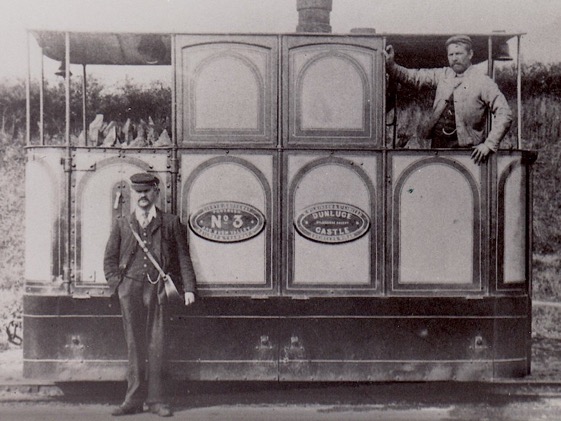
An excellent study of Steam Tram No 3 ('Dunluce Castle') with a conductor and a driver — photo undated, but probably taken in the late 1880s or 1890s. The driver is in railway footplate-like attire with cotton jacket and flat cap, whilst the conductor has a single-breasted jacket, waistcoat and soft-topped peaked cap, more than likely self purchased. Photo courtesy of Jim Kilroy, tram archivist at the National Transport Museum (see link).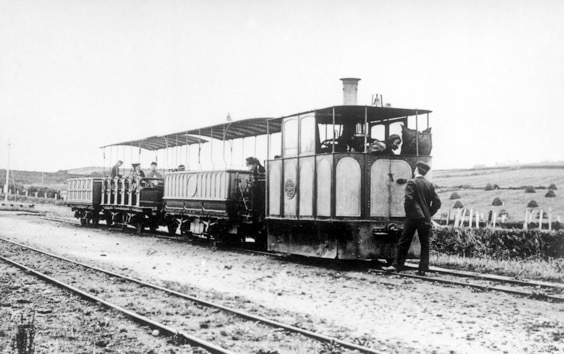
An evocative summer-time photo of Steam Tram No 3, 'Dunluce Castle', at Giant's Causeway — photo undated, but probably taken around the turn of the century. Photo courtesy of David Gladwin, with thanks to Trevor Preece.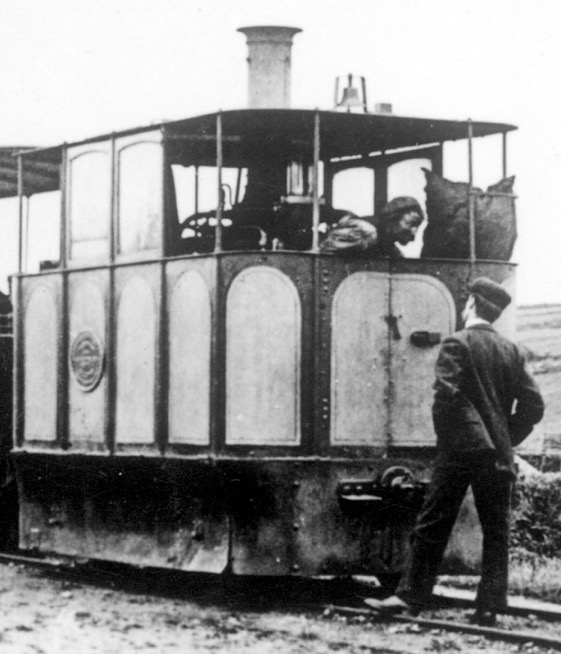
An enlargement of the above photograph showing the driver, who is absolutely filthy, listening intently to the man on the track; the driver is wearing a shirt, waistcoat and flat cap. 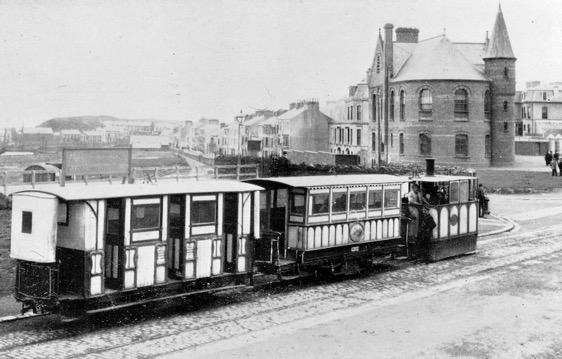
Steam Tram No 1 or No 2, with Power Cars Nos 4 and 7 in Portrush — although undated, this must have been taken prior to the conversion to overhead electric pick-up in 1899. The driver is wearing a cotton jacket, whilst the conductor has a single-breasted jacket with a cap. Photo courtesy of the Tramways and Light Railway Society, with thanks to David Voice.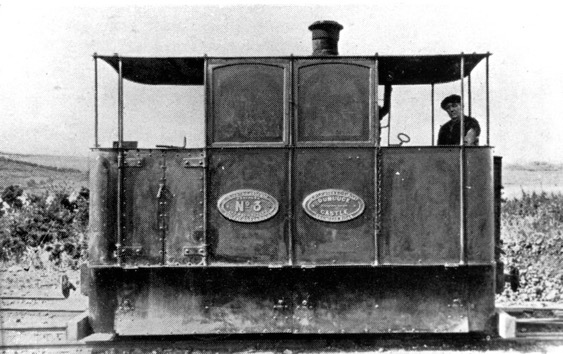
Steam Tram No 3 again, but a photo which is thought to have been taken on 15th July 1933, well after it had left the tramway, seen here working for a contractor near the River Bann. Photo courtesy of Jim Kilroy, tram archivist at the National Transport Museum (see link).
Motormen and conductors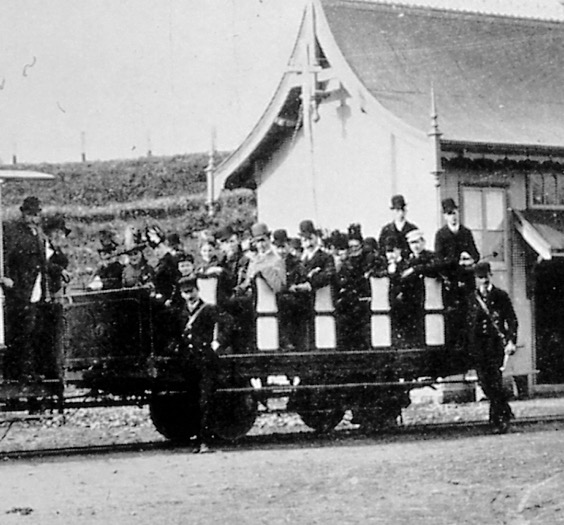
Two conductors stand with a fully laden toastrack trailer at Giant's Causeway in third-rail days — photo undated, but probably taken not too long after it opened in 1887. Both conductors are wearing single-breasted jackets and kepi-style caps. Photo courtesy of the Tramways and Light Railway Society, with thanks to David Voice.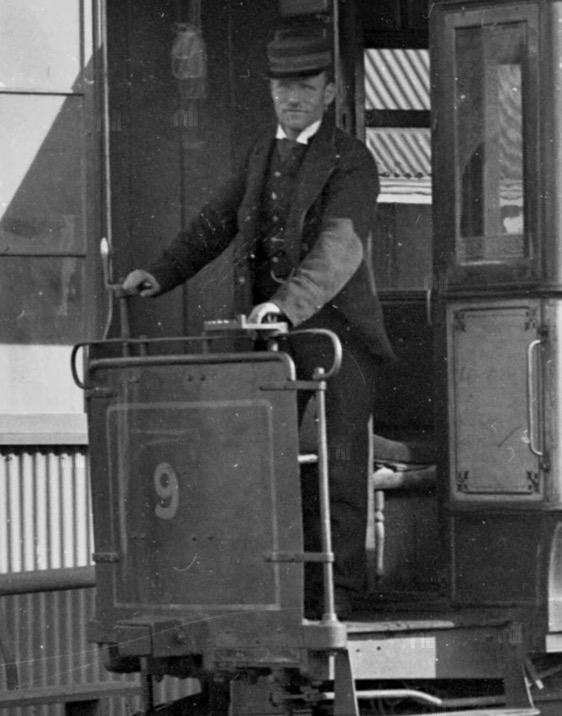
A shot taken by photographer Robert French at the terminus at Giant's Causeway, and very possibly on the same day as the previous shot. The motorman — at the controls of Tramcar No 9 — is wearing a waistcoat, single-breasted jacket and a kepi-style cap; the latter has a hat band, but does not appear to bear a badge, though this is difficult to say for certain. Original photo believed to be held in the National Library of Ireland.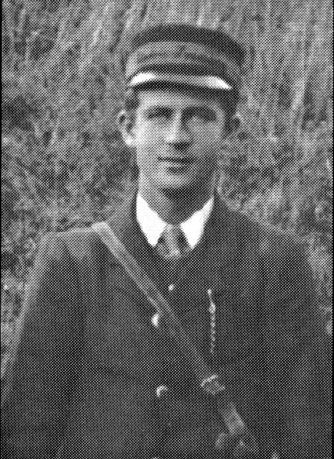
Conductor William Jubilee Maxwell — photo undated, but probably taken in the early-Edwardian era (he was born in 1887 and worked for the tramway for 14 years, presumably from around 1900 to 1914, when he enlisted). He died in 1919 from TB, possibly as a result of being gassed. His obituary states that he had been a motorman and electrician, though in this photo, he is clearly carrying a conductor's cash bag. His hat band bears embroidered script-lettering: 'Electric Tramway'. He was the son of William Robert Jubilee Trail Maxwell, who was the Tramway Operational & Maintenance Engineer for 57 years. The whereabouts of the original image is currently unclear; please do let me know if you can shed any light on this.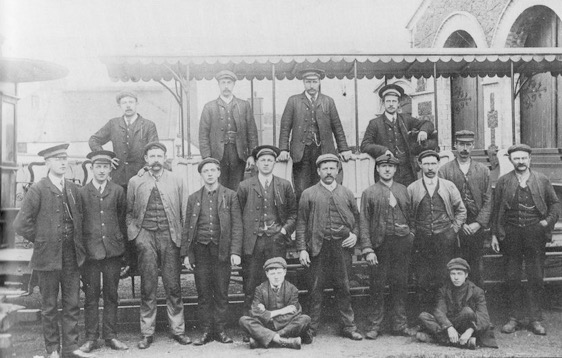
A rare depot staff shot, probably taken around 1910. The uniformed men in tensioned-crown peaked caps are presumably conductors and motormen, whilst those in light-coloured cotton jackets are probably steam tram drivers, the remainder being more than likely fitters. William Jubilee Maxwell is believed to be the individual standing on the back row, far right. The whereabouts of the original image is currently unknown.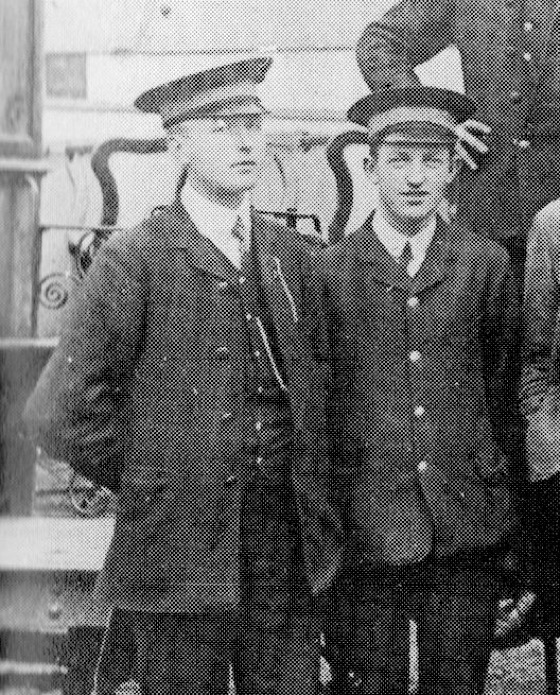
An enlargement of the above photograph showing two of the uniformed staff. Both men are wearing single-breasted jackets and tensioned-crown peaked caps; the latter bearing a light-coloured hat band. 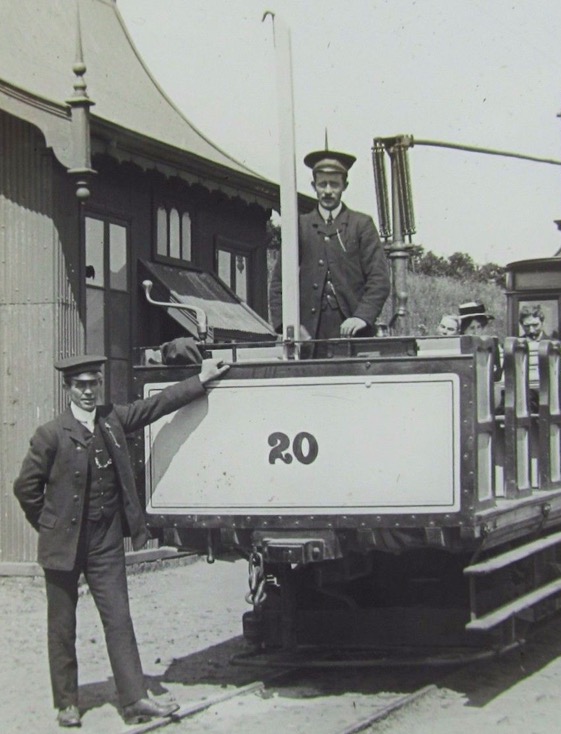
Tramcar No 10 and crew at Giants Causeway — photo undated, but probably taken in the mid-to-late Edwardian era. Source unknown.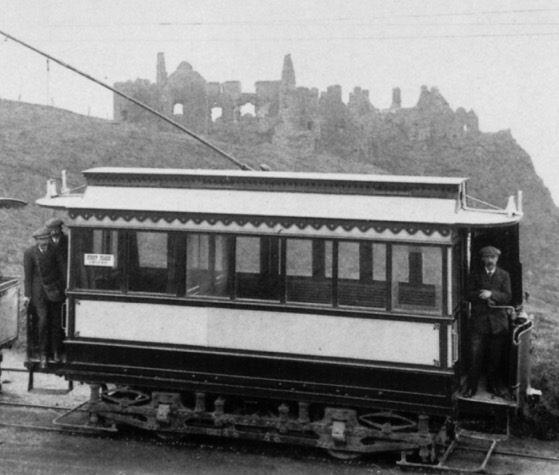
Tramcar No 9 captured at perhaps the most photographed location on the tramway, Dunluce Castle — photo undated, but probably taken in the 1920s; both the driver and the conductor are wearing informal attire and the large flat caps that were particularly popular during this decade. Photo courtesy of the Tramways and Light Railway Society, with thanks to David Voice.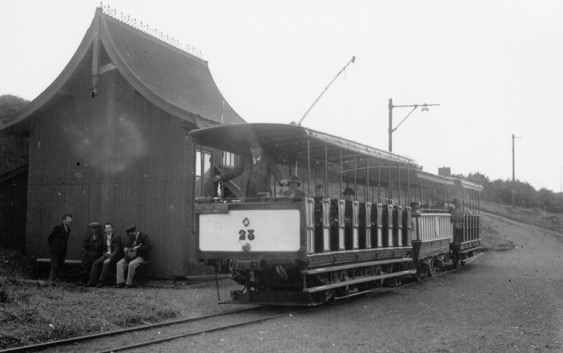
An unvestibuled No 23 stands at the terminus at Giant's Causeway — photo undated, but probably taken in the 1930s. Photo courtesy of the Tramways and Light Railway Society, with thanks to David Voice.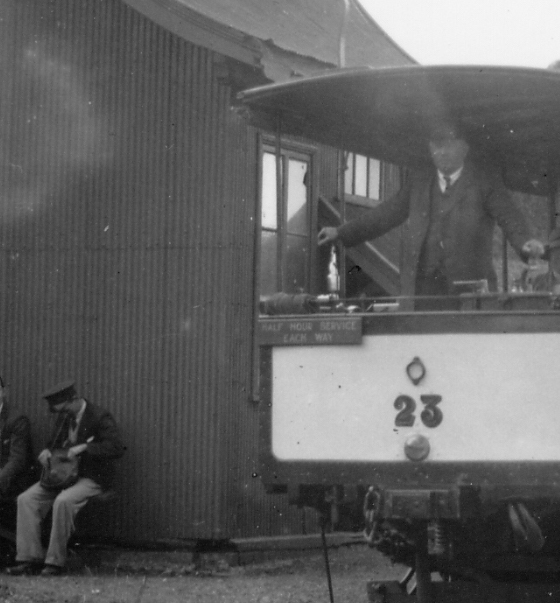
An enlargement of the above photograph showing the conductor (seated left) and the motorman (at the controls), both of whom are wearing plain, single-breasted jackets and tensioned-crown peaked caps. The jackets were probably informal, so they may have been a relief crew.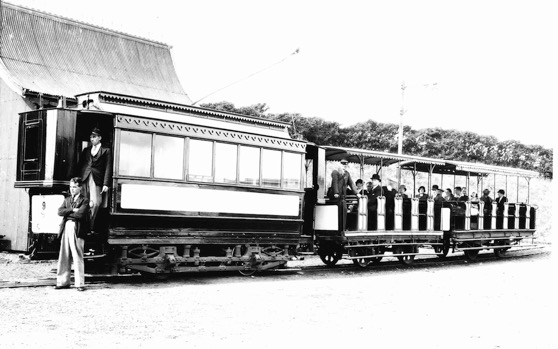
Tramcar No 9 in unrebuilt condition at Giant's Causeway — photo undated, but probably taken in the late 1930s. Photo courtesy of Jim Kilroy, tram archivist at the National Transport Museum (see link).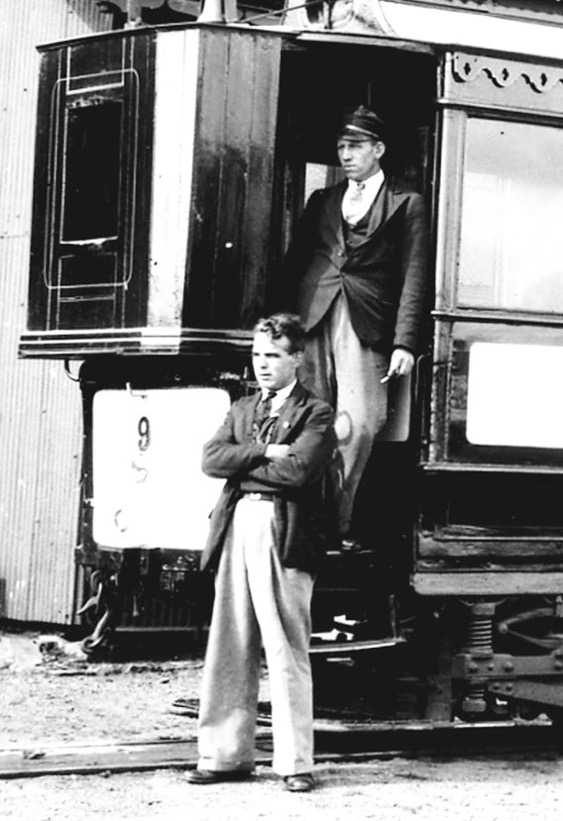
An enlargement of the above photograph showing the motorman (on the platform) and a man who is probably a passenger. The motorman appears to be wearing an informal jacket without badges of any kind, along with the usual tensioned-crown peaked cap.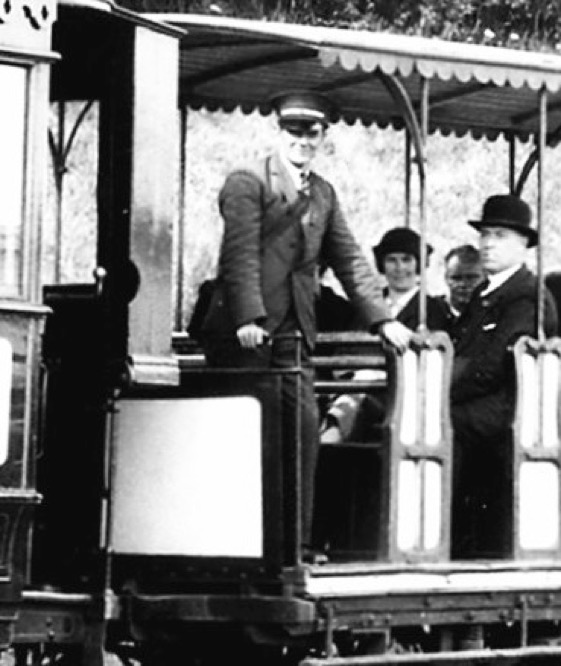
Another blow-up of the preceding photo, this time showing the conductor, again in what would appear to be an informal jacket and a tensioned-crown peaked cap; the latter appears to carry a light-coloured hat band.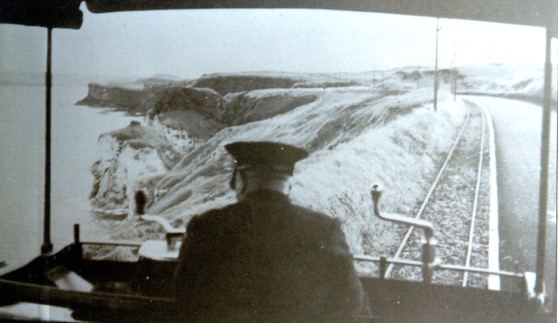
A rare view of a motorman, taken from behind, between White Rocks and Dunluce — photo undated, but probably taken in the late 1940s. Photo courtesy of Jim Kilroy, tram archivist at the National Transport Museum (see link).